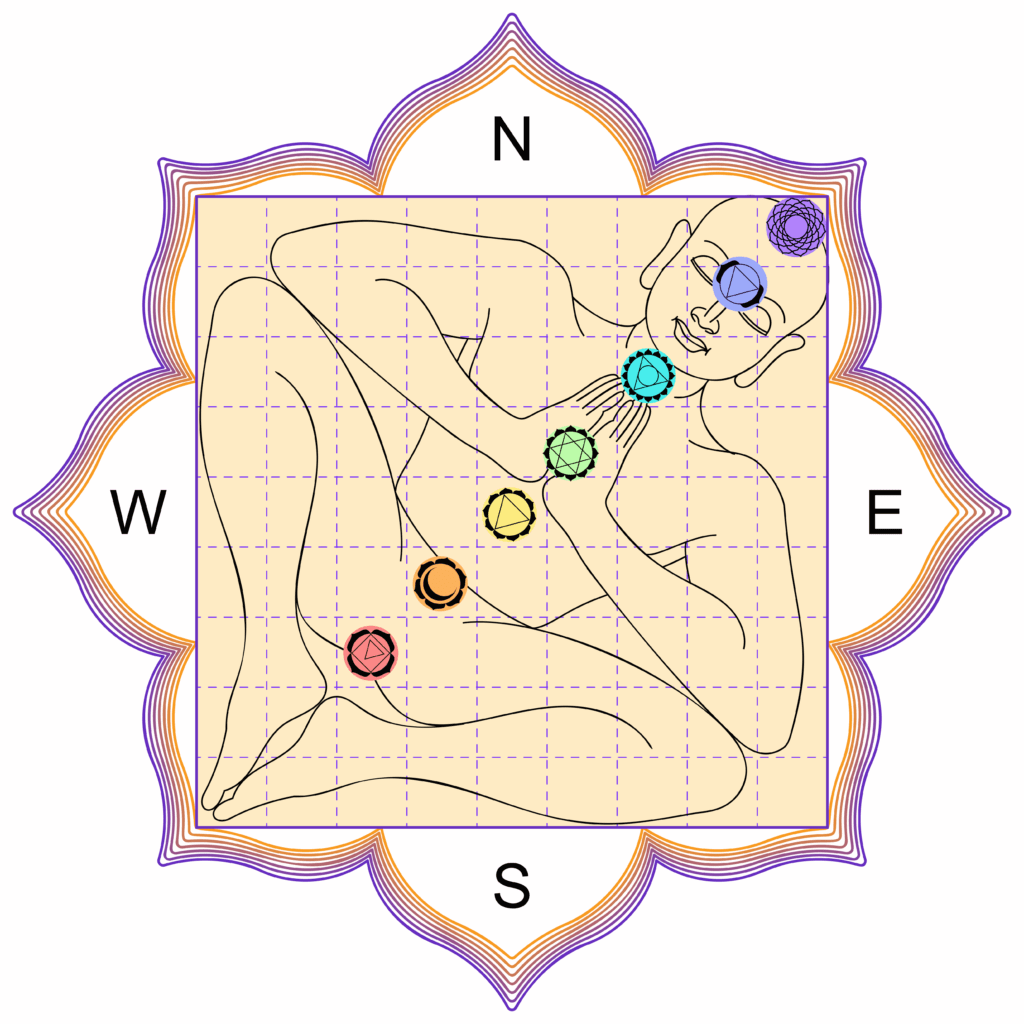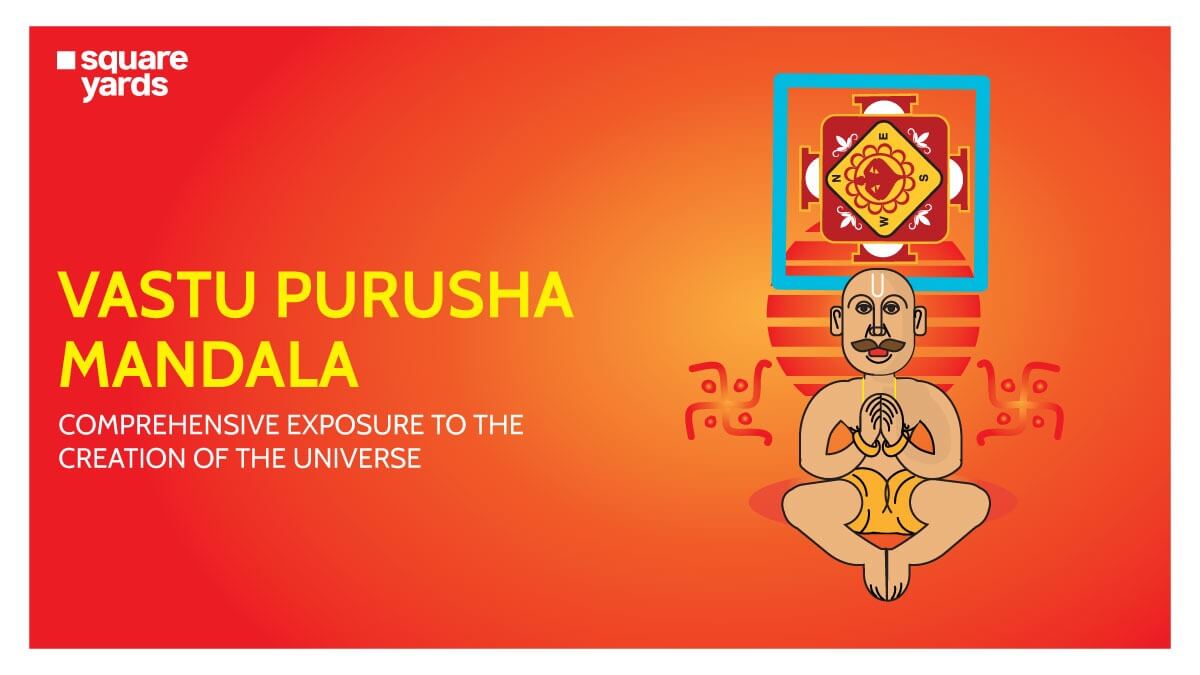The Vastu Purusha Mandala is an essential component of the Vastu Shastra and serves as a theoretical and graphical analysis. It is a foundation for creating designs, like a spiritual layout that considers the movement of astronomical objects and spiritual powers. Purusha is the Sanskrit word for vitality, strength, life, or celestial humanity. It also depicts the earth from all four sides, illustrating the perpendicular link between dawn and dusk.
According to Vaastu Purusha's design, the quad corners' depiction is known as the Chaturbhuji, and within this, Prithvi Mandala is also represented.
Additionally, the square plan will reveal the positions of the stars, sun, moon, luminaries, and a human's exact zodiac symbol based on their birth date and location.
In this blog, we will glance at the intriguing history of the Vaastu Purusha Mandala, which arose from the Vastu shastra. And also provide a brief explanation of some factors of the Vastu Purusha Mandala.
Table of contents
What is Vastu Purusha Mandala?
Vastu Purusha Mandala is an ancient Indian architectural concept that helps in designing buildings in harmony with nature and cosmic energies. It's like a blueprint that represents the energy of a place, with a symbolic figure lying down, head in the northeast and feet in the southwest. This figure is believed to influence the energy flow of the building. Architects and builders use this concept to arrange rooms, doors, and other elements in a way that promotes well-being and prosperity for the people living or working in the building.
"Griha Pravesh Vastu Mandala" refers to the Vastu principles followed during housewarming ceremonies, ensuring auspiciousness and harmony in the new home's energy flow.
The Origin : Vastu Purusha Mandala

It all begins with Brahma, the Planet's founder, experimenting with several species. Brahma used all his abilities to create an ideal man-made, and that is how Vaastu Purusha was introduced.
Vishwakarma Prakash's old Vastu manuscript tells a fascinating narrative about Vastu Purusha Mandala's origins. The plot revolves around a bloody battle between the Gods, devtas, demons, and asuras. In the battle, God Shiva fought for the devtas, and on the other side, Andhaka Asur fought for the asuras.
When the conflict occurred, a few drops of sweat landed on the ground from Lord Shiva's head. The devtas and asuras were both terrified when a giant entity appeared from that exact spot, namely, Vaastu Purusha, who started claiming to be Lord Shiva's son and got approval to eat Triloka, because of his insatiable appetite. Additionally, Triloka is a combination of three worlds the land of God (Swargaloka), the middle men's kingdom (Mrityuloka), and the house of the Asuras and Devtas(Pataloka). Due to this, the gods were terrified when the enormous creature began eating Trilok and turned to Brahma to preserve the Planet. Furthermore, to save Triloka, Lord Brahma sought the assistance of Astha Dikapalakas, the protector of the eight cardinal points and instructed other Devtas and Asuras to kill him with his head to the northeast and feet to the southwest.
The core part of Vastu Purusha was created by Brahma, which consisted of 44 other deities and 45 energy fields. It symbolizes the diverse facets of our lives inhabiting the other components of our body. The chart conveys the message of worshipping Brahma for your overall well being. According to Hinduism, an individual must perform a Vastu Purusha Mandala planning ritual before partaking in a new endeavour for good luck.
The Scientific of Vastu Purusha
Mandala refers to a map or blueprint that reflects the cosmos figuratively. 'Purusha' means celestial man, spirit, relationship, strength, or life.
The Vastu Purusha Mandala is the metaphysical plan that encompasses the journey of supernatural forces and heavenly bodies. It is an essential component of Vastu Shastra. Mathematically, it is a diagrammatic representation of the stars and planetary movements.
Importance of the Vastu Purusha Mandala
Vastu Shastra is a theoretical construct because the earth consists of living or non-living organisms. It also holds vibrations and positive and negative energy. Vastu Purusha Mandala represents a human being's activity, and its origin has been explained above. Besides, every minute, any inherent magnetic and positive energy fields happen due to Vastu Purusha Mandala principles.
It begins with the excavation of a blank area and ends with the construction process with Brahma and the other 44 deities; therefore, 45 in total are called energy fields. Generally, they gradually occupy their assigned positions as the edifice progresses. Vastu design for residences, workplaces, and industries is determined by Mandala.
Vastu Purusha Mandala: Elements, Gods, and Deities
According to Vastu Purusha Mandala, all living beings are composed of a combination of five elements, namely the sky (Akasha), air (Vayu), water (Jal), fire (Agni), and earth (Prithvi), and these elements are also known as Panchabhutas. Moreover, the world's surface magnetism and energetic zones support the growth of surrounding architecture, which aids in the creation of the most optimal household. Besides, numerous rooms are built to maintain adequate natural light as well as provide a sense of solitude to relatives.
The Vastu Purusha Mandala diagram splits the globe into squares. All of these fair parts are defended by 45 gods, of which some protect you from internal conflicts, while others help protect you from external factors.
The innermost area of the home is run by Brahma. It is claimed by Vastu that this portion is the gem of the house, which maintains all the positive energy of the surrounding area.
The picture depicts the oldest Vastu Purush sculpture, situated in Rameshwara temple, Karnataka.
Vastu Purush Direction
Regardless of the time of day, living beings face various challenges. The ancient Vastu experts represented the eight cardinal angles who split the 24 hours into eight halves. They constructed and aligned different rooms of a home towards the eight cardinal points so that the occupants might receive tranquility from the sun's rays based on their location. Some of the directions are as follows:
- North-East: Brahma Muhurta time varies from 3 am to 6 am, immediately before sunrise, when the sun points towards the apartment's north-eastern corner. However, these hours are considered beneficial for yoga, meditation, or study. Moreover, the puja or meditation rooms should be located in the northeast corner.
- East: When the sun is in the eastern portion of the home from 6 am to 9 am. However, the east direction is an excellent location for a bathroom and a perfect time for bathing.
- South-East: The most excellent time to prepare meals is during the day between 9 am and 12 pm. The sun lies in the home's southeast corner, which is also an ideal location for a kitchen space.
- South: The interval between noon and 3 pm is the best time to recover after lunch, also known as Vishranti. The sun is in the south, which is the perfect time to sleep.
- West: 6 pm to 9 pm are ideal for dining, resting, or studying. The sun rises in the west, making this the most acceptable spot for a dining room or sitting area.
- North-West: The period to sleep is between 9 pm to midnight; The sun is in the northwest corner of the home. This area is also suitable for a spare bedroom.
- North: The time from midnight to 3 am; the sun appears in the north, the time of darkness and secrecy. The northern direction is the best place to hide valuables and keep them protected.
Frequently Asked Questions
How many types of mandala art are there?
Sandy, education, and the curing mandala are the three primary varieties of mandalas.
Where should be the image of Vastu Bhagwan?
By the Vastu Purusha Mandala, the idol and portrait of any god or demon should be placed on the walls towards the east or north side of the resistance of worship. If the worshipper faces the representation of God pointing north, then the worshipper will confront the south.
What is the Vastu grid?
The Vastu Purusha Mandala can be thought of as the architecture's fundamental grid. A mandala is a grid in a square that represents the Purusha, or the universal man, who is pointed down by numerous gods and goddesses in each of its segments.
What is Marma points in Vastu Shastra?
The location where the guiding lines intersect is known as Maha marma. The six primary components of Vastu Purusha, such as a living being, comprise the skull, jaw, pulse, stomach, and lower part of the body. These delicate points must not be harmed in any way.





